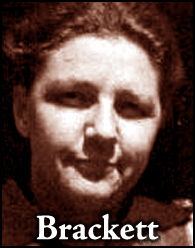Sunday, September 20, 2009
posted by Leo Grin

Fabrice Tortey, editor of the recently released and well-received French REH critical volume Échos de Cimmérie reports:
Leo,
Both Les nombreuses vies de Conan (edited by Simon Sanahujas) and Échos de Cimmérie are nominated for Le Grand Prix de l’Imaginaire, a prestigious French award dedicated to SciFi, Weird & Fantasy fiction (category “Essay”). The winners will be proclaimed on October 28 during Les Utopiales, a famous Sci-Fi festival. The third book in competition for the category is Dans les griffes de la Hammer by Nicolas Stanzick, about Hammer studios and France.
The fact that two of the three essay volumes in competition are dedicated to Howard is significant. Let’s hope that it will be a springboard for Howard Studies in France!
Fabrice
But Fabrice — how can this be? I was told that Howard is one of the least-studied pulp authors! Invigorating scholarship has yet to be attempted, right? My God, THE ACADEMICS HAVEN’T EVEN PRESENTED THEIR PCA PAPERS YET!
But seriously, let’s all extend our congratulations to Fabrice, and wish him and his buddy Simon good luck at the ceremony next month. He worked really hard on his book for several years, and deserves all the credit in the world that comes his way.
Friday, September 18, 2009
posted by Steve Trout
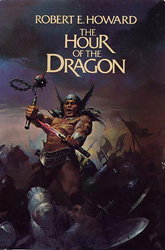
In addition to the twenty-one Conan stories that Howard actually wrote, there has been a plethora of Conan pastiches, written by various authors, in an effort to fill gaps in the Cimmerian’s career.
While Howard did leave a few very brief fragments and outlines for other Conan stories — which have been completed through “posthumous collaboration” — later writers have”revised” non-fantasy adventures to turn them into Conan stories, and have further diluted Howard’s Conan through a vast body of frank pastiches.
These are not Conan stories — not Robert E. Howard’s Conan — and have no more validity in relation to the stories than any Conan stories you might yourself decide to write. {…} It is a matter of spirit.
Karl Edward Wagner, forward to “Hour of the Dragon,” Berkley paperback, 1977.
It’s never been said better.
Wednesday, September 16, 2009
posted by Deuce Richardson
Erik Mona and Planet Stories pulled off a sweet commemoration of a diamond jubilee this last June with their reprinting of The Sword of Rhiannon. It was in the June 1949 issue of Thrilling Wonder Stories that Leigh Brackett’s, “The Sea Kings of Mars,” first appeared. With Brackett’s approval, that tale has been reprinted with the title of The Sword of Rhiannon ever since (or nearly so).
Beginning with the Ace Double that featured Conan the Conqueror on the flip-side, nearly all subsequent printings of Brackett’s novel sported The Sword of Rhiannon as the title. Simple (socio-) economics. As Leigh noted in her afterword to The Best of Leigh Brackett, post-war editors were getting more leery of publishing her type of ERB-influenced tales; tales where the Red Planet supported an ancient, humanoid population amidst which Earthmen found adventure. This was due to the (at the time) recent (and dream-shattering) advances in the sciences. Apparently, faster-than-light drives were more “real” than the possibility of life on Mars (though the opposite seems just as likely today). Renaming this story “The Sword of Rhiannon” allowed a better chance of an unwitting (and lucky) reader picking up the book and then getting pulled in by Brackett’s hard-boiled, Howardian prose. The fact that Leigh persisted in writing later tales like “The Secret of Sinharat” and “The People of the Talisman” is a testament to her authorial courage and passion for the Martian “sword-and-planet” sub-genre.
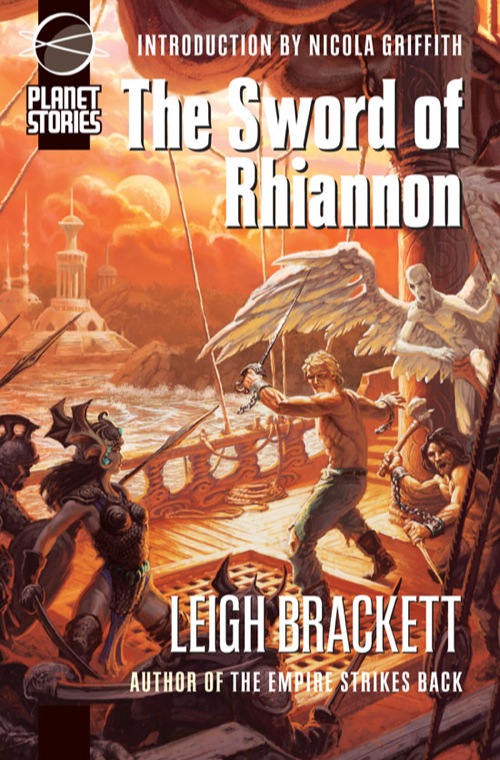
Paizo’s new reprinting of The Sword of Rhiannon is the best showcase for this novel thus far assayed, in my opinion. The cover by Daren Bader is well-wrought and action-packed. Nicola Griffith’s introduction, while quite thoughtful and appreciated by yours truly, could have been a bit better, perhaps. Then again, that leaves room for the tossing-in of my two coppers, doesn’t it? On with the tale…
(Continue reading this post)
Friday, September 11, 2009
posted by Steve Trout
When Karl Edward Wagner got “The Hour of the Dragon” into print sans editorial amendments, I was curious about the three terms for helmet that Howard had used, apparently not realizing, according to some, that they defined “three specific and different” styles.
When Conan dons the helmet, it’s a “plain morion”. Later, it’s a “basinet” and later still it is a “burganet.”
Researching this in my “Complete Encyclopedia of Arms and Weapons,” I quickly found that these are actually not very specific terms, but describe evolving trends, many of which are quite different from their predecessors. And rather than being distinct from each other, the burgonet and the morion merge in a hybrid known aptly as the burgonet-morion.
The basinet, which is commonly associated with jousting knights, actually started off as a simple cap with an attached coif, rather like Barry Smith’s depiction of Turanian helmets. It then evolved into the great bellows-visored helmet worn by knights in tourneys. A basinet offers good protection to the neck. The morion is associated with the Spanish conquistadors. Most were made of two plates joined along the middle with a mohawk-like “comb” running from front to back, but some were made with only one piece, which would make them similar to basinets.
The same is true of the burgonet, as it could also be made with one piece.
I think it is totally possible, even likely, that Howard knew exactly what these words meant when he used them. The Nemedian smith who created this helmet knew nothing of burganets, basinets, or morions when he made it — they wouldn’t be invented until our own age. Yet what he made had some basic characteristics of all, and in trying to describe what is basically an alien artifact from another age Howard used terms that would let a reader imagine something along the lines of what it was; a single-plate cap with an aventail or coif to protect the neck, a fall or eyeshade to keep the eyes sheltered, and an openable visor.
Wednesday, August 26, 2009
posted by Deuce Richardson
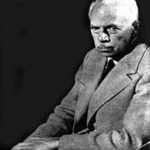
Lamb’s obituaries in 1962 barely mentioned his fiction. By then, the cheap magazines that had published his yarns were long forgotten except by a few passionate collectors. Like a burial mound’s hidden hoard of treasure, they lay undisturbed, awaiting their rediscovery by Mr. Jones — and now a growing band of admirers.
Such is the coda of John J. Miller’s article concerning Harold Lamb’s career and the publication of Swords From the West, one of a brace of (very recently published) editions collecting Lamb’s work put out by Bison Books.
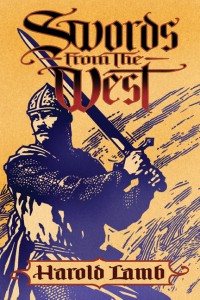
(Continue reading this post)
Wednesday, August 5, 2009
posted by Deuce Richardson
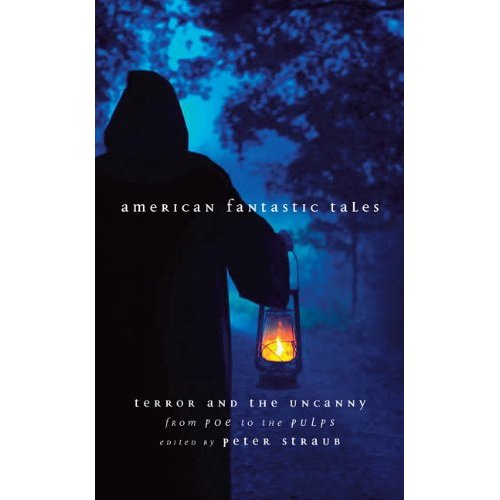
Edgar Allan Poe • Bret Harte • Charlotte Perkins Gilman • Ambrose Bierce • Edith Wharton • Ellen Glasgow • Robert E. Howard • H. P. Lovecraft • Clark Ashton Smith • Robert Bloch •
That’s the lead-in list of authors on the Library of America site for their forthcoming edition of American Fantastic Tales: Terror and the Uncanny From Poe to the Pulps, edited by Peter Straub. Apparently, Robert E. Howard rates in the “Top Ten” of American weird/horror authors (published prior to 1940) out of a total of forty-five. We are grading on the curve here, but in a good way. Since one would assume all authors in a Library of America collection should be “A-List” writers of some sort, Robert E. Howard would seem to be in the “A+” grouping.
(Continue reading this post)
Sunday, July 26, 2009
posted by Leo Grin
The latest progress report booklet from the 2009 World Fantasy Convention (being held October 29-November 1 in San Jose, CA) has announced that the Special Guests this year will be Richard Lupoff and Donald Sidney-Fryer. You can download a copy of the progress report here and read all about it on page 6.

A young Dick Lupoff
One of my reasons for starting The Cimmerian was to once again get some of the founding fathers of the modern pulp/fantasy critical arena on record about REH. Among many other accomplishments, Richard Lupoff wrote the seminal volume of Edgar Rice Burroughs criticism, Master of Adventure, (a book that served as one of Don Herron’s major influences when producing his Robert E. Howard critical volume The Dark Barbarian). Donald Sidney-Fryer is, of course, the premier Clark Ashton Smith scholar, doing much of the major early research and publishing the bio-bibliography Emperor of Dreams. Both have written perceptively about REH in the past, and were well-known admirers of the Texan’s writings. It was grating, therefore, to see both critics excluded from the various REH fanzines and journals in the modern era.
(Continue reading this post)
Wednesday, July 22, 2009
posted by Deuce Richardson

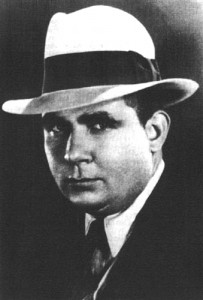
Last week, Robert E. Howard got name-checked in the New York Times Magazine, due in equal measure to Jack Vance and Carlo Rotella. Jack’s contribution consisted of being the subject of the article and of having been a fan of Weird Tales during the Depression. Rotella did his part by being an assiduous journalist and a reader of discerning tastes.
(Continue reading this post)
Sunday, June 28, 2009
posted by Leo Grin
 At long last, Fabrice Tortey reports that his large and meaty French tome about Robert E. Howard, Échos de Cimmérie, is at the printer and will be available shortly. It promises to be filled with interesting essays about Howard from both French and American writers. Last year Donald Sidney-Fryer read the galleys in the original French and reviewed the book in TC V5n6. I also published some of the contents of the book, translated into English, in TC V5n2.
At long last, Fabrice Tortey reports that his large and meaty French tome about Robert E. Howard, Échos de Cimmérie, is at the printer and will be available shortly. It promises to be filled with interesting essays about Howard from both French and American writers. Last year Donald Sidney-Fryer read the galleys in the original French and reviewed the book in TC V5n6. I also published some of the contents of the book, translated into English, in TC V5n2.
Information on ordering the book, and a breakdown of the contents, can be found here.
UPDATE: The book is now available at Amazon here.
Wednesday, May 27, 2009
posted by Deuce Richardson
“Before Conan, there was Kane, a Puritan swordsman on a restless search for justice.”

That’s the lead-in from Nick Owchar’s, “Man in black: Robert E. Howard’s Solomon Kane,” published this May 24th in his monthly column for the Los Angeles Times. Owchar, deputy book editor for the LA Times, turns in a quite respectable piece on the Man From Devonshire (and his creator). His column, “The Siren’s Call” (a title I truly dig), was a joy and revelation once I (very recently) discovered it. Dear readers, brethren, kindred and fellow travellers, Ol’ Nick is one of us. Peruse his previous columns (future blog-fodder, for me) and tell me it ain’t so. (Continue reading this post)











